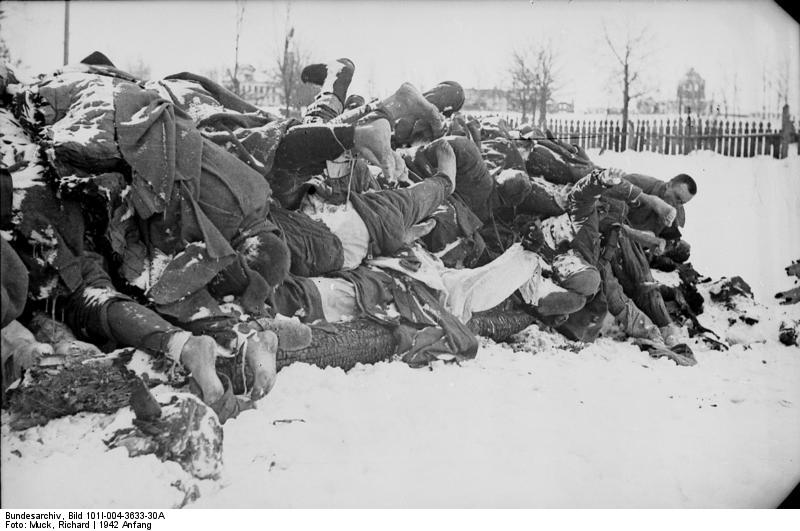
Dead Soviet soldiers in Poland, 1942.
(c) Richard Muck, via German Federal Archives and Wikimedia.
The article had first been published on Political Violence @ a Glance’s website, which “answers questions on the most pressing problems related to violence and protest in the world’s conflict zones”.
A widely accepted claim is that women make up the majority of casualties in contemporary wars, but no academic or policy source offers the sort of gender disaggregated data necessary to draw such a conclusion. In effect, this claim has become a myth about armed conflict that has taken on a life of its own within both the policy and research communities.
This claim of predominantly female victimhood seems to have originated from the often-cited (and incorrect) figure that 90% of casualties in contemporary wars are among civilians. Two assumptions are often made with regard to this quote. The first is that the word ‘casualties’ is misinterpreted as meaning ‘fatalities’. Second, ‘civilians’ is understood as synonymous with women.
If we restrict ourselves to only conflict-related deaths, or fatalities which occur within the context of fighting or the deliberate killing of civilians by a belligerent, the existing evidence suggests that men are in fact far more vulnerable to victimization than women, with a 1.3 to 10 times higher likelihood of death. Yet this fact of male victimhood has garnered little attention to date.
Expanding our definition of victimhood to encompass other types of conflict-related violence may change the picture. The topic of sexual violence in armed conflict has been covered here before. While it’s generally assumed that women are the primary targets for sexual violence during armed conflict, it’s worth noting that men are victims of sexual violence as well, and that there is little data available that can provide leverage on the issue. In terms of indirect violence, i.e. war-related disease and malnutrition, an ICRC study suggests that women are represented disproportionately amongst refugees and IDPs and other studies suggest that women are more frequently affected than men in terms of indirect deaths from armed conflict.
Data on indirect casualties, however, are sparse and gender disaggregated data even more so, which impedes the drawing of empirically-based claims of female victimhood. Conflict fatalities on the other hand — the most studied measure of casualties to date — suggest, as we have seen, a distribution of victimhood that stands in sharp contrast to the prevailing view of predominantly female victimhood. It is interesting to note that, while there is a general acceptance of women being targeted because of their gender, such ideas carry little traction when applied to men, despite the greater empirical evidence.
This bias against acknowledging male victims is evident in the current use of the term ‘gender-based’ violence, which is defined by many influential agencies as exclusively reserved for violence against women. Yet prevailing gender stereotypes also have deadly consequences for men, be it through forced recruitment and death as a soldier or through ‘pre-emptive’ executions of non-combatants of ‘battle age’ — as happened in Srebrenica. Gender stereotypes that equate a human’s sex with its specific role in combat can result in viewing all men as potential combatants, while rarely ever questioning women’s placement in the category of civilians. This prevailing stereotypical dichotomization results in non-combatant males being denied civilian status (and hence protection), as is currently happening at the Syrian-Jordanian border where the government of Jordan has refused entry to single male refugees.
Why should male victimhood matter? At the most basic level, practitioners developing violence protection, reduction, and prevention strategies need sound empirical data in order to create adequate and effective programming. If the goal of a mission is to protect vulnerable and disproportionately targeted civilian populations, it is important to understand who composes these populations, be they men or women.
On a more societal level, raising awareness of male victimhood may be a strategic key in obtaining a change in gender roles. As long as men are not seen — and see themselves — as victims of unequal gender roles, few men will engage in an active reconstruction of hegemonic masculinity. Since feminists have long emphasized the importance of highlighting counter-stereotypical female roles (such as the female warrior) as a strategy for changing gender relations, it is surprising that male victims have not yet been politicized for the same purpose.





I used to be in a recent conflict, during the nineties, and we cleaned up 99% males, but it is…